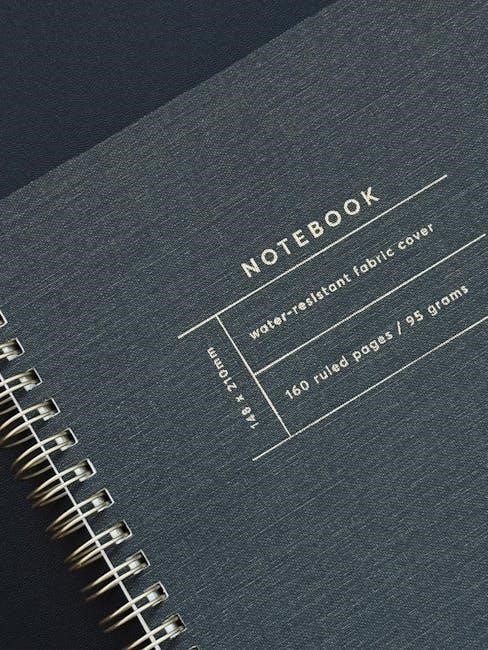Choosing the right planner size is crucial for effective organization and productivity. With various options available‚ from pocket-sized to A4‚ selecting a planner that fits your lifestyle can enhance your planning experience. This guide explores common planner sizes‚ helping you determine the ideal fit for your needs. Whether you prioritize portability‚ ample writing space‚ or a balance between the two‚ understanding planner sizes ensures you find a tool that seamlessly integrates into your daily routine and supports your organizational goals.

Common Planner Sizes
Planners come in a variety of sizes to suit different lifestyles and preferences. Common options include pocket-sized‚ personal-sized‚ A5‚ half-letter‚ and A4 planners. Each size offers unique benefits‚ from the portability of smaller planners to the expansive space of larger ones. Whether you need a compact companion for on-the-go use or a spacious canvas for detailed planning‚ understanding these standard sizes helps you choose the perfect fit for your organizational needs and personal style.
2.1 Pocket-Sized Planners
Pocket-sized planners are the most compact and portable option‚ designed for those who value convenience and ease of use. Typically measuring around 3.5 x 5.5 inches (89 x 127 mm)‚ these planners are small enough to fit into a pocket‚ purse‚ or even the palm of your hand. Their compact size makes them ideal for on-the-go individuals who need to stay organized without being weighed down by a bulky planner.

Despite their small size‚ pocket-sized planners are surprisingly functional. They often include essential features like weekly or daily spreads‚ to-do lists‚ and space for notes. Some designs even incorporate creative layouts or minimalist aesthetics to maximize usability within the limited space. This makes them perfect for quick references‚ jotting down reminders‚ or tracking small but important tasks throughout the day.
The portability of pocket-sized planners is one of their standout advantages. They are lightweight and easy to carry‚ ensuring you can have your planner with you at all times. Whether you’re commuting‚ traveling‚ or running errands‚ these planners slip effortlessly into small bags or pockets‚ making them a practical choice for busy lifestyles.
Additionally‚ pocket-sized planners are great for those who prefer a no-frills approach to organization. They encourage simplicity and focus‚ helping users avoid clutter and stick to the essentials. For individuals who find larger planners overwhelming or unnecessary‚ these compact tools provide a streamlined way to stay organized without sacrificing functionality.
Overall‚ pocket-sized planners are a versatile and practical option for anyone seeking a discreet‚ portable‚ and user-friendly organizational tool. Their small size belies their ability to help users maintain structure and clarity in their daily lives‚ making them a popular choice for both planner newcomers and seasoned enthusiasts alike.
2.2 Personal-Sized Planners
Personal-sized planners strike a perfect balance between portability and functionality‚ making them a popular choice for many users. Typically measuring around 3.75 x 6.75 inches (102 x 152 mm)‚ these planners are slightly larger than pocket-sized options but still compact enough to fit easily into most bags or purses. Their size provides ample writing space while maintaining a sleek‚ portable design.

One of the key advantages of personal-sized planners is their versatility. They cater to a wide range of needs‚ from daily task management to long-term goal setting. Many personal-sized planners feature weekly or monthly spreads‚ along with additional sections for notes‚ habit tracking‚ or goal setting. This makes them ideal for individuals who want a structured yet flexible planning system.
The slightly larger size of personal-sized planners allows for more detailed planning compared to pocket-sized options. Users can write comfortably without feeling cramped‚ making them suitable for those who prefer to jot down more information or use stickers and decorations. At the same time‚ their compact dimensions ensure they remain lightweight and easy to carry‚ avoiding the bulkiness of larger planner sizes.
Personal-sized planners are particularly popular among students‚ professionals‚ and anyone who needs a reliable organizational tool for daily use. They are also a great option for those who prefer a “one-and-done” approach‚ as they often provide enough space to consolidate schedules‚ to-do lists‚ and notes into a single‚ cohesive system.
Overall‚ personal-sized planners offer an excellent middle ground for individuals who want more functionality than a pocket-sized planner but still value portability. Their balanced design makes them a practical and stylish choice for staying organized on the go.
2.3 A5 Planners
A5 planners are among the most popular and versatile options available‚ offering a perfect balance of size and functionality. Measuring 5.8 x 8.3 inches (127 x 203 mm)‚ these planners provide ample space for detailed planning while remaining portable enough to fit into most bags or backpacks. Their dimensions make them a favorite among planner enthusiasts‚ as they strike a harmonious balance between usability and convenience.
The A5 size is particularly appealing to individuals who prefer a comprehensive approach to organization. With enough room for daily‚ weekly‚ or monthly spreads‚ A5 planners allow users to map out their schedules in detail. They also often feature additional sections for goal setting‚ habit tracking‚ and notes‚ making them a multifaceted tool for managing various aspects of life. This flexibility makes A5 planners suitable for a wide range of users‚ from students and professionals to homemakers and creatives.
One of the standout features of A5 planners is their availability in different binding styles. Whether you prefer a softbound cover for a sleek look‚ a spiral-bound design for easy flipping‚ or a ring agenda for customization‚ there’s an A5 planner to suit your preferences. This variety ensures that users can choose a format that aligns with their unique needs and planning style.
A5 planners are also praised for their ability to foster creativity. The generous page size provides a canvas for users to express their personality through stickers‚ doodles‚ and colorful decorations. This creative freedom not only enhances the planning experience but also makes the planner a reflection of the user’s individuality.
2.4 Half-Letter Planners
Half-Letter planners‚ measuring 5.5 x 8.5 inches or 127 x 203 mm‚ serve as a middle ground for users who find A5 planners slightly too small but A4 planners too large. This size is ideal for those who need more space for detailed planning without sacrificing portability. The Half-Letter size offers a generous canvas for writing‚ making it perfect for individuals who prefer to include extensive notes‚ lists‚ or creative elements like stickers and doodles.
One of the key advantages of Half-Letter planners is their versatility. They provide enough room for intricate scheduling while remaining compact enough to fit into medium-sized bags or backpacks. This makes them a practical choice for students‚ professionals‚ and anyone who needs a balance between functionality and ease of transport. The size is also well-suited for collaborative planning‚ as it allows space for multiple schedules or shared tasks without feeling cluttered.
The Half-Letter size is particularly popular among those who value a professional aesthetic. Its larger dimensions make it suitable for use in work environments‚ where it can double as a polished accessory during meetings or presentations. At the same time‚ its portability ensures it can transition seamlessly from the office to personal use‚ making it a versatile tool for all aspects of life.
Despite their larger size compared to A5 planners‚ Half-Letter planners are still lightweight and easy to handle. They often come in various binding styles‚ such as ring agendas or spiral-bound formats‚ which cater to different preferences and needs. This flexibility allows users to customize their planning experience‚ whether they prefer a more structured layout or the freedom to add and remove pages as needed.
2.5 A4 Planners
A4 planners‚ measuring 8.3 x 11.7 inches or 216 x 279 mm‚ are the largest option available‚ offering an expansive workspace for detailed planning. Comparable to the US letter size‚ these planners are ideal for individuals who require a comprehensive organizational tool. Their generous dimensions provide ample room for intricate scheduling‚ making them perfect for meticulous schedulers‚ detail-oriented note-takers‚ or those who enjoy mapping out every aspect of their day.
The primary advantage of A4 planners is their ability to display a broad overview of your schedule. With the extra space‚ you can visualize your entire month or week at a glance‚ which is particularly beneficial for long-term planning. This feature allows you to identify patterns‚ allocate time effectively‚ and maintain a clear understanding of your goals and commitments. Additionally‚ the large format accommodates diverse sections for goal setting‚ habit tracking‚ or project management‚ catering to various planning needs.
A4 planners also offer a canvas for creativity. If you enjoy incorporating art‚ stickers‚ or colorful elements into your planning routine‚ the expansive layout provides ample space for self-expression. This creative freedom makes the planning process more enjoyable and allows you to personalize your organizer‚ reflecting your unique style and preferences.
Professionally‚ A4 planners exude sophistication. Their size and layout make them a polished accessory in work environments‚ suitable for meetings or networking events. They project an image of organization and preparedness‚ aligning seamlessly with professional settings. Furthermore‚ their large size allows for consolidating multiple planners or tools into one‚ simplifying your organizational system and reducing clutter.

However‚ the portability of A4 planners can be a drawback. Their bulk and weight make them less convenient to carry‚ especially for those frequently on the move. They also occupy more desk space‚ which may be a disadvantage for those with limited work areas or a preference for minimalism. Despite these challenges‚ A4 planners remain an excellent choice for those who prioritize detailed planning and creativity over portability.

Comparing Planner Sizes to Standard Paper Sizes
Understanding planner sizes in relation to standard paper sizes can help you make an informed decision when choosing the right planner for your needs. Standard paper sizes‚ such as A4‚ A5‚ and letter sizes‚ serve as a common reference point for comparing planner dimensions. By aligning planner sizes with these familiar measurements‚ you can better visualize how they will fit into your daily routine and workspace.
Planner sizes are often categorized based on their similarity to standard paper sizes. For instance‚ A5 planners‚ measuring 5.8 x 8.3 inches‚ align perfectly with the A5 paper size‚ making them a popular choice for those who value both portability and functionality. Similarly‚ A4 planners‚ at 8.3 x 11.7 inches‚ match the A4 paper size‚ offering a spacious layout for detailed planning and creativity.
Half-letter planners‚ measuring 5.5 x 8.5 inches‚ are slightly larger than A5 but smaller than A4‚ providing a balanced option for those who find A5 too compact and A4 too bulky. This size is particularly useful for individuals who need more writing space than a personal-sized planner but still prefer a portable option.
Personal-sized planners‚ typically measuring 3.75 x 6.75 inches‚ are smaller than A5 but larger than pocket-sized options. They are ideal for everyday use‚ offering enough space for scheduling without compromising on portability. Pocket-sized planners‚ at around 3.5 x 5.5 inches‚ are the most compact option‚ designed for quick notes and on-the-go planning.
By comparing planner sizes to standard paper sizes‚ you can easily determine which planner will best suit your lifestyle and preferences. Whether you prioritize portability‚ functionality‚ or a balance of both‚ understanding these comparisons ensures that your planner becomes a seamless and effective tool for staying organized.
Additionally‚ this comparison helps in maintaining consistency if you plan to use printables or binders alongside your planner. Knowing how planner sizes align with standard paper sizes allows you to create custom inserts or print templates that fit perfectly‚ enhancing your overall planning experience.

Pros and Cons of Larger Planners
Larger planners offer ample space for detailed planning‚ creativity‚ and organization‚ making them ideal for those who need a comprehensive workspace. They provide a clear overview of schedules‚ accommodate additional notes‚ and can serve as a central hub for collaborative planning. However‚ their size and weight may limit portability‚ making them less convenient for on-the-go use. While they excel in functionality‚ their bulkiness and space requirements can be a drawback for those prioritizing convenience and minimalism.
4.1 Advantages of Larger Planners
Larger planners offer several advantages that make them a popular choice for many individuals. One of the most significant benefits is the ability to capture a comprehensive overview of your schedule. With more space to spread out‚ you can visualize your entire month or week at a glance‚ which is incredibly helpful for long-term planning. This broader perspective allows you to identify patterns‚ allocate time effectively‚ and maintain a better grasp of your overarching goals and commitments.
Another advantage of larger planners is their versatility. They often come equipped with diverse sections catering to various planning needs‚ such as dedicated areas for goal setting‚ habit tracking‚ or project management. This makes them a multifaceted tool that can adapt to different aspects of your life. Whether you’re managing personal tasks‚ professional projects‚ or family schedules‚ a larger planner can accommodate these specialized segments without sacrificing the clarity of your primary schedule.
The spacious layouts of larger planners also provide an inviting canvas for creativity. If you enjoy incorporating art‚ stickers‚ or colorful elements into your planning routine‚ a larger planner offers more room to express your artistic flair. This creative freedom not only makes the planning process more enjoyable but also allows you to infuse your personality into your organizational tool. Additionally‚ the extra space is ideal for jotting down important notes‚ phone numbers‚ or addresses‚ making it a centralized hub for critical information.

Larger planners are also well-suited for collaborative planning. If you’re involved in shared projects or household schedules‚ a bigger planner can serve as a central point for integrating multiple schedules‚ deadlines‚ and commitments. This fosters better coordination among family members‚ roommates‚ or team members. Furthermore‚ the professional appearance of larger planners makes them a sophisticated accessory for work environments‚ projecting an image of organization and preparedness during meetings or networking events.
Finally‚ larger planners often eliminate the need for multiple planning tools. With their extensive space‚ you can consolidate your schedules‚ to-do lists‚ and project plans in one centralized location. This simplifies your organizational system‚ fostering a more streamlined and efficient planning process. Overall‚ the advantages of larger planners make them an excellent choice for individuals seeking a comprehensive and flexible organizational solution.
4.2 Disadvantages of Larger Planners
While larger planners offer numerous benefits‚ they also come with several drawbacks that may make them less practical for certain users. One of the most notable disadvantages is their impact on portability. As the size increases‚ so does the weight and bulk of the planner‚ making it less convenient to carry around. This can be a significant issue for individuals who are constantly on the move‚ whether commuting‚ traveling‚ or attending meetings. A larger planner may become an unwieldy addition to your daily essentials‚ forcing you to choose between convenience and functionality.

Another downside of larger planners is their space consumption. They take up more room on your desk or in your bag‚ which can be problematic if you have a compact workspace or prefer a minimalist environment. This issue becomes particularly pronounced if you already struggle with clutter or have limited storage options. The sheer size of the planner may also make it difficult to fit into smaller bags or purses‚ further limiting its portability and practicality.

The extensive layouts of larger planners can also be overwhelming for some users. While the extra space is advantageous for detailed planning‚ it may feel too vast for those who prefer a more streamlined approach. This can lead to a sense of obligation to fill every inch of the page‚ potentially causing stress or a feeling of being overwhelmed. Additionally‚ the abundance of space may result in underutilization‚ as some individuals may not have enough content to fill the generous layouts‚ leaving parts of the planner unused.
Finding a bag that can accommodate a larger planner can also be a challenge. If you prefer smaller purses or backpacks‚ fitting a big planner may pose a practical problem. This limitation can be frustrating for individuals who want to carry their planner with them at all times but find it difficult due to size constraints. Furthermore‚ the larger size may make the planner more conspicuous‚ which could be a drawback for those who prefer a low-profile or discreet organizational tool.
Lastly‚ larger planners may not be the best choice for individuals who prefer simplicity or are new to planning. The expansive layouts and numerous sections can be intimidating‚ especially for those who are still developing their planning routine. This may lead to frustration or a reluctance to use the planner consistently‚ defeating its purpose as an organizational tool. Despite their many advantages‚ larger planners may not be the ideal solution for everyone‚ particularly those who value portability‚ simplicity‚ or a more streamlined approach to planning.

No Responses